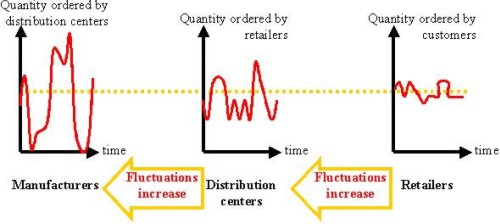Recession Showed the Bullwhip Effect in Action, Arizona State Researchers Say |
| Материал из категории News of logistics (in English) |
| 04.04.2010 20:31 |
|
Метки (тэги, tags): The "Bullwhip Effect," a concept developed in the 1990s by Procter & Gamble and Dr. Hau Lee of Stanford, is one of the most important basic concepts in supply chain. The Bullwhip Effect, in great summary, means that as you go further back up stream in the supply chain, and away from actual customer demand, information signals about that demand are delayed and distorted. So, for example, while actual consumer pull in retail may be relatively stable, demand, usually in the form of orders, starts to swing more widely to direct retail suppliers and even more so to the suppliers' suppliers. This effect is caused by a lack of visibility, latency in information flows, and the behavior of individuals, among other factors. It is called The Bullwhip Effect because the shape of the demand curve for suppliers looks more like a whip in action than the much more flat curve for those near actual consumption, as shown in the chart nearby. Anecdotally, there was evidence of this in the midst of and coming out of the great recession. In January, the Wall Street Journal ran a story on how industrial equipment giant Caterpillar was intentionally creating a bullwhip of sorts for its own supply chain. Caterpillar "told its steel suppliers that it will more than double its purchases of the metal this year-even if the company's own sales don't rise one iota," the article noted. Its CEO cited the "great inventory burn-off being over" as leading to the planned increase in orders. In other words, Caterpillar was running overly lean on components and raw materials during the worst of the recession, and was now going to catch up. The company said if its sales increased 15% in 2010, its orders to suppliers would likely double. Caterpillar suppliers: welcome to the bullwhip club. Now, a graduate student at Arizona State University's Carey School of Management has found some quantitative evidence that the Bullwhip Effect was alive and well during the economic downturn that really began in 2007. "Inventories varied the most within manufacturers, second most with wholesalers and least with retailers. Also, manufacturers responded most slowly to the drop in consumer demand, and they responded in the most volatile fashion," notes Tingting Yan, a doctoral candidate at ASU. This was based on his analysis of public data across these industry sectors reported during the recession. Yan also found that although the month-to-month volatility of consumer demand increased threefold during the recession, monthly variation in retailer inventories actually decreased by 4% during the same time period. Wholesalers were able to reduce month-month variation in inventory, but their inventory levels increased by two percent; while manufacturers saw their inventories increase and became one-and-a-half times more volatile on a month-to-month basis. Yan also found retailers began adjusting their inventories at the same time as consumer demand started to drop (November 2007), while manufacturers and wholesalers didn't begin to reduce inventories until well into 2008.
Were Signals Missed?
Didn't everybody know that end consumer demand was falling? What served to create a Bullwhip Effect once again? "Theoretically, the bullwhip effect shouldn't have happened because everyone up and down the supply chain knew that a decrease in consumer demand was occurring," said Srimathy Mohan, an assistant professor at ASU. "So the fact that it did happen tells us that wholesalers and manufacturers weren't believing these macro-level market signals. Instead, they continued to just pay attention to what their downstream partners were doing." The ASU researchers also say that technology may be partly to blame, or rather the combination of technology and staffing practices. As most manufacturers have relied more on technology and less on people for forecasting and replenishment, driving the number of SKUs managed by an individual demand planner to skyrocket in recent years, it leaves less bandwidth for personal judgment and correction.
The Bullwhip Effect
"Don't forget that many of these inventory and demand decisions are automated inside complex computer systems,"Kevin Dooley, professor of supply chain management at ASU, also commented. "It might not be that the managers of wholesalers and manufacturers weren't paying attention or didn't observe demand signals, but that they didn't respond as quickly because these market signals didn't reach their ordering systems until months later." We'd add one more factor: manufacturers, for example, are driven by many factors, inventory levels being just one. Cost per unit and plant utilization also rank high, which tends to drive manufacturers to be favor building stuff, even at the risk of higher inventories. Long, offshore supply chains were probably also a factor, as those orders may have been placed months before, with those deliveries really lagging what was happening in the market at that point in time. Additionally, struggling retailers may have found more financial necessity to move more quickly to improve cash flow, while many manufacturers may have not had quite the same level of immediate urgency to reduce inventories.
Source:
Метки (тэги, tags): Последние похожие материалы:
Более поздние похожие материалы:
|
| Обновлено 17.10.2016 06:01 |
Последние новости на сайте
Пример материалов из категории "Задачи по логистике"
Facebook-страница
Фрагмент из задачи
Группа на Linkedin
(более 4000 участников)
Группы на Facebook
Результаты тестов
| Последние результаты | ||
|---|---|---|
| <->(Лог-М) Тема 01. Основні поняття логістики (27 тест.завдань) | 51.85 % | |
| <->(Лог-М) Тема 11. Транспортна логістика (15 тест.завдань) | 26.67 % | |
| <-->Стоит ли Вам выбирать профессию менеджера по логистике? | 64.00 % | |
| Перейти к тестам |





